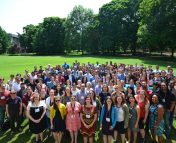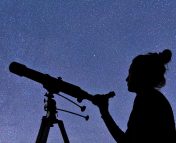Title: The Nonbinary Fraction: Looking Towards the Future of Gender Equity in Astronomy
Authors: Kaitlin C. Rasmussen et al.
First author’s institution: University of Notre Dame
Journal: arXiv (open access)
In the past couple decades, astronomy has made large strides in gender equity and inclusion. Recently, recognition of transgender and non-binary identities in the field has improved, such as through optional pronouns on conference badges. Work that addresses the status of gender equity in astronomy however does not often recognise these identities, and although those efforts are based in genuinely good intentions, “in practice, the primary subjects and beneficiaries of such work have typically been limited to cisgender, white, heterosexual, abled women.”
Today’s white paper, written as a part of the discourse around the Astro2020 Decadal Survey, aims to broaden the audience that benefits from this work. Although some may claim that there are “not enough” non-binary scientists for this to be an important topic, there is clear support for better gender inclusion, as evidenced by the 70+ authors and co-signers on this white paper. Additionally, this argument of “not enough” is inherently flawed — in inclusion efforts, we need to value every member of our community and their unique identities. Throughout the white paper, and today’s Astrobite, the term non-binary is understood as “an umbrella term for the diverse range of gender identities not included in the binary categories of male and female”. The goal is to discuss and make recommendations on how to include nonbinary and transgender identities in the push for inclusion in our field, relying on the work of trained social scientists and academic literature on gender studies.
In the many attempts to quantify the notorious gender gap in astrophysics, there’s almost always a reliance on the idea that male vs. female is a binary choice, as this paper points out. The consistent reinforcement of this dichotomy erases the existence of people who live outside that binary, forcing them into either misgendering or total exclusion. Imagine being told, “Sorry, there’s not enough people like you to be important, so we left you out entirely.” This represents another issue: (mis)using statistics to claim who matters enough to the field to be counted, reducing the complexity of gender and inclusion. Understandably, actions like this have very real psychological (and professional) consequences for our marginalized community members.
The white paper describes how surveys and studies on gender in astronomy have also fallen into many other problematic routines. Other than the limited gender category options, these data rely on volunteers identifying gender by appearance, name, or a combination of external factors. This is a flawed approach, relying on limiting social customs and constructs surrounding gender. The only way to surely know a person’s gender identity is to simply ask them (self-identification). Unfortunately, in many studies, there isn’t even any participation or testimony from marginalized genders, leading to a further lack of understanding of their needs and experiences.
Bring in the Experts
As this white paper declares, “gender is not a new area of study and gender inclusion is not a new problem. There have been efforts to make improvements in other disciplines for decades, and gender studies has existed as a field for at least the last century.” The authors of this white paper implore astronomers to utilize the “established and well-researched understandings of gender and its individual and structural manifestations” instead of attempting “to solve problems of gender inclusion without consulting those whose fields have long been focused on this work”. If you were starting a new research project in an unfamiliar subject, you wouldn’t assume you know everything already — you’d defer to the experts, and learn all you could from them to make sure your work is the best it can be. This is exactly what astronomers should be doing with trained gender and social studies professionals when undertaking a study on gender equity, to avoid harming the people already marginalized based on their identity.
What can we do now?
Astronomers wishing to understand the state of gender equality should follow certain best practices to ensure their surveys and demographics are whole and helpful. This paper suggests they reconsider their methodological choices (understanding that testimony is valuable data and not just “anecdotal”), include multiple facts of gender in their demographic data collection, and only use data from self-identification (e.g. surveys). Importantly, the authors suggest that trained social scientists are included, with funding to hire them and pay for their services.
On a departmental level, the white paper suggests that the traditional “women in physics” groups should become marginalized gender identity groups. Curricula and workforce development practices should include topics such as gender studies, critical race theory, ethics, and science, technology, and society studies (STSS) to educate our community members. Peer reviews, such as for telescope time allocation, should be anonymous to avoid gender bias. Overall, departments should utilize resources that already exist, such as the Nashville recommendations and the LGBT+ Inclusivity Best Practices.
On a personal level, we can all start by educating ourselves; remember to first seek out resources of your own before asking a marginalized person for free labor, since minority community members often already must unfairly devote their time to educating others. By listening to and amplifying the voices of our marginalized community members, and advocating for their needs as allies, we can push for these changes in astronomy to make an inclusive, safe, and welcoming community.
Author Note: Special thanks to Oliver Hall (@asteronomer) for editing and co-writing this post!



